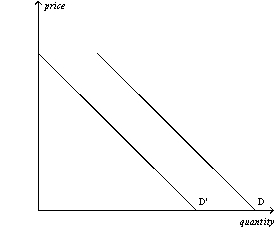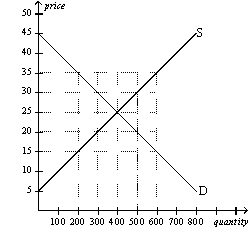A) an auctioneer helps set prices and arrange sales.
B) there are only a few sellers.
C) the forces of supply and demand do not apply.
D) no individual buyer or seller has any significant impact on the market price.
Correct Answer

verified
Correct Answer
verified
True/False
A decrease in supply shifts the supply curve to the left.
Correct Answer

verified
Correct Answer
verified
True/False
If there is an improvement in the technology used to produce a good,then the supply curve for that good will shift to the left.
Correct Answer

verified
Correct Answer
verified
Multiple Choice
Suppose roses are currently selling for $40 per dozen,but the equilibrium price of roses is $30 per dozen.We would expect a
A) shortage to exist and the market price of roses to increase.
B) shortage to exist and the market price of roses to decrease.
C) surplus to exist and the market price of roses to increase.
D) surplus to exist and the market price of roses to decrease.
Correct Answer

verified
Correct Answer
verified
Multiple Choice
When it comes to people's tastes,economists generally believe that
A) tastes are based on forces that are well within the realm of economics.
B) tastes are based on historical and psychological forces that are beyond the realm of economics.
C) tastes can only be studied through well-constructed,real-life models.
D) since tastes do not directly affect demand,there is little need to explain people's tastes.
Correct Answer

verified
Correct Answer
verified
Multiple Choice
A competitive market is one in which
A) there is only one seller,but there are many buyers.
B) there are many sellers and each seller has the ability to set the price of his product.
C) there are many sellers and they compete with one another in such a way that some sellers are always being forced out of the market.
D) there are so many buyers and so many sellers that each has a negligible impact on the price of the product.
Correct Answer

verified
Correct Answer
verified
Multiple Choice
If suppliers expect the price of their product to fall in the future,then they will
A) decrease supply now.
B) increase supply now.
C) decrease supply in the future but not now.
D) increase supply in the future but not now.
Correct Answer

verified
Correct Answer
verified
Multiple Choice
You have been asked by your economics professor to graph the market for lumber and then to analyze the change that would occur in equilibrium price as a result of recent forest fires in the west.Your first step would be to
A) decide which direction to shift the curve.
B) decide whether the fires affected demand or supply.
C) graph the shift to see the effect on equilibrium.
D) None of the above are correct.
Correct Answer

verified
Correct Answer
verified
Multiple Choice
Holding the nonprice determinants of supply constant,a change in price would
A) result in either a decrease in supply or an increase in supply.
B) result in a movement along a stationary supply curve.
C) result in a shift of demand.
D) have no effect on the quantity supplied.
Correct Answer

verified
Correct Answer
verified
True/False
In a perfectly competitive market,the goods offered for sale are all exactly the same.
Correct Answer

verified
Correct Answer
verified
Multiple Choice
Which of these statements does not apply to market economies?
A) Prices prevent decentralized decision making from degenerating into chaos.
B) Prices coordinate the actions of millions of people with varying abilities and desires.
C) Prices ensure that anyone who wants a product can get it.
D) Prices ensure that what needs to get done does in fact get done.
Correct Answer

verified
Correct Answer
verified
Multiple Choice
For the general population,a 10 percent increase in the price of cigarettes leads to a
A) 1 percent reduction in the quantity demanded of cigarettes.
B) 4 percent reduction in the quantity demanded of cigarettes.
C) 10 percent reduction in the quantity demanded of cigarettes.
D) 12 percent reduction in the quantity demanded of cigarettes.
Correct Answer

verified
Correct Answer
verified
Multiple Choice
Which of the following demonstrates the law of supply?
A) When leather became more expensive,belt producers decreased their supply of belts.
B) When car production technology improved,car producers increased their supply of cars.
C) When sweater producers expected sweater prices to rise in the near future,they decreased their current supply of sweaters.
D) When ketchup prices rose,ketchup sellers increased their quantity supplied of ketchup.
Correct Answer

verified
Correct Answer
verified
Multiple Choice
Soup is an inferior good if
A) the demand for soup falls when the price of a substitute for soup rises.
B) the demand for soup rises when the price of soup falls.
C) the demand curve for soup slopes upward.
D) the demand for soup falls when income rises.
Correct Answer

verified
Correct Answer
verified
Multiple Choice
The sum of all the individual supply curves for a product is called
A) total supply.
B) market supply.
C) aggregate supply.
D) total output.
Correct Answer

verified
Correct Answer
verified
Multiple Choice
Figure 4-3  -Refer to Figure 4-3.The movement from D' to D could be caused by
-Refer to Figure 4-3.The movement from D' to D could be caused by
A) a decrease in price.
B) a decrease in income,assuming the good is inferior.
C) buyers expecting the price of the good to fall in the near future.
D) an increase in the price of a complement.
Correct Answer

verified
Correct Answer
verified
Multiple Choice
Which of the following would cause price to decrease?
A) a decrease in supply
B) an increase in demand
C) a surplus of the good
D) a shortage of the good
Correct Answer

verified
Correct Answer
verified
Multiple Choice
Figure 4-8  -Refer to Figure 4-8.At what price would there be an excess supply of 200 units of the good?
-Refer to Figure 4-8.At what price would there be an excess supply of 200 units of the good?
A) $15
B) $20
C) $30
D) $35
Correct Answer

verified
Correct Answer
verified
True/False
Local cable TV companies frequently are monopolists.
Correct Answer

verified
Correct Answer
verified
Multiple Choice
A table that shows the relationship between the price of a good and the quantity demanded of that good is called a
A) price-quantity schedule.
B) buyer schedule.
C) demand schedule.
D) demand curve.
Correct Answer

verified
Correct Answer
verified
Showing 61 - 80 of 467
Related Exams